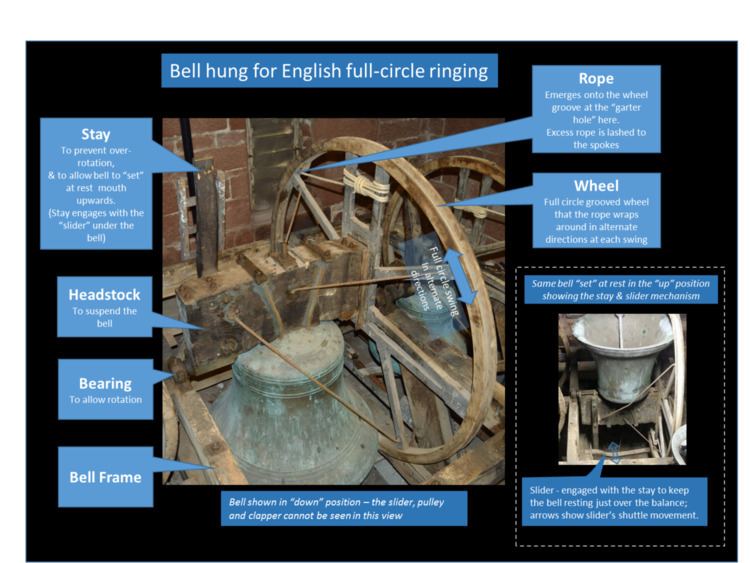 | ||
Full circle ringing is a method of ringing a bell such that it swings in a complete circle from mouth upwards around to mouth upwards and then back again repetitively.
Contents
By ringing in a full circle, it was found historically that the speed of the bell could be altered and the interval between successive soundings (strikes) of the bell could be accurately controlled. A set of bells rung in this manner can be made to strike in different accurate and sustained sequences. Normally there is one ringer per bell, due to the bell weights involved.
The sets of bells range from a few hundredweight (100 kg) up to a few tons (4,000 kg) and are most commonly associated with churches as a means of calling the congregation to worship. There are a few sets in secular buildings.
However, smaller sets of bells, usually known as "mini-rings" have come recently into existence for training, demonstration or leisure purposes, with bells weighing just a few kilogrammes.
Mechanics
There are several variations of the means of exerting control of the bell by the ringers, but the fundamental principal of being able to control and alter the speed of the bell striking is common to all full circle techniques.
The bell is attached to a headstock, historically made of wood but now more often steel. This has to withstand the dynamic force of the bell as it swings, up to three times its static weight. At each end of the headstock are trunnions or bearing pins which are located in bearings in the gudgeons attached to the frame. The frame is rigidly attached to the fabric of the tower.
Within the bell is a clapper which consists of a solid shaft, (wood, iron or steel) a clapper ball (wrought iron or steel) and a flight. The size of the flight determines the rate at which the clapper swings, and therefore the point in time at which it strikes the bell.
Bells are normally left mouth down (for safety.) Before ringing, the bells are swung in increasing arcs until the bell is mouth uppermost. When the ringer desires to make a stroke, the bell is swung around a full circle, the clapper striking once.
The distinctive sound
The sound made by a bell rung full-circle has two unique subtle features: rapid strike decay and the doppler effect.
Because the clapper strikes the bell as it rising to the mouth upwards position, it rests against the bell's soundbow after the strike, and the peak strike intensity decays away quickly when the clapper helps to dissipate the vibration energy of the bell. This enables rapid successive strikes of multiple bells, such as in change ringing, without excessive overlap and consequent blurring of successive strikes. In addition, the movement of the bell imparts a doppler effect to the sound, as the strike occurs whilst the bell is still moving.
Both these effects give full circle ringing of bells in an accurate sequence a distinctive sound which cannot be simulated by stationary chimed bells.
English
The bells are mounted within a bellframe of steel or wood and each bell is suspended from a headstock fitted to bearings so that the bell may rotate.
The headstock is fitted with a wooden stay, which, in conjunction with a slider, limits maximum rotational movement to just over a full circle, and allows the bell to be set or rested mouth uppermost. A large wheel is fitted to the headstock and the rope wraps and unwraps as the bell rotates backwards and forwards. Within the bell is a clapper which strikes the thickest part of the bell mouth called the soundbow. In English ringing a set of bells is known as a "ring of bells" and an example of a ring of eight bells is shown mouth upwards in the rest position in the accompanying picture.
The ringers stand in a ringing chamber below, and the ropes pass through holes in the ceiling. The rope has a woollen grip called the sally while the lower end of the rope is doubled over to form an easily held tail-end.
Bells hung in this fashion gave rise to the invention of English Change ringing in the 17th century because the striking interval of the bells could be controlled. There are over 5,000 rings of bells in England, the vast majority in towers of the Anglican church, and an estimated 40,000 bell ringers.
Bell cage
At East Bergholt there is England's only bell cage which is in the graveyard, where the bells are rung by the ringers standing beside the bells and pulling on the headstock directly, rather like the Bolognese technique described below.
Veronese
Veronese bells are rung with a wheel and rope, but do not have stays. The bells often swing outside the towers and so the clappers are wired in case of breakages. The bells are usually at the top of high towers and are rung from the ground floor, so most of the rope is steel as is the wheel.
The Veronese bellringing art consists of slow moving pieces of music called by a Maestro.
Bolognese
Bolognese bells have neither stay nor wheel, but in place of the wheel is an A-frame. The ringers are distributed below and among the bells, pulling on the A-frame either with their hands or by ropes. During the raise of the bells the ringers may stand on the large wooden headstocks to impart the necessary force.
The Bolognese bell ringing art consists of prearranged methods rung at a rate of change similar to English call changes.
